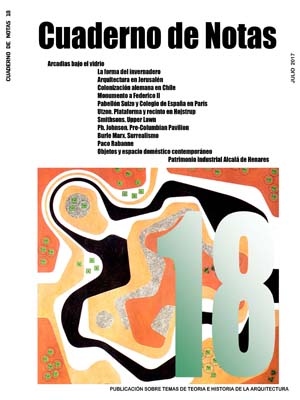Arcadias bajo vidrio
DOI:
https://doi.org/10.20868/cn.2017.3595Palabras clave:
Invernaderos, casas solares, tipología, termodinámicaResumen
Los invernaderos se han visto tradicionalmente como poco más que una anécdota en la historia de la construcción, aunque en realidad fueran el tipo arquitectónico más innovador del siglo XIX. Conjugando la rigurosa atención a los problemas del clima con el uso de los materiales industriales y los nuevos sistemas de calefacción, los invernaderos dieron pie a soluciones formales y técnicas extremadamente eficaces, que están en la base del diseño pasivo contemporáneo. Este artículo da cuenta de los orígenes del invernadero, de su desarrollo y consolidación como tipo termodinámico, y de su rápida extrapolación a otros usos convertido ya en ‘pseudomorfo’, para acabar desvelando su íntima relación con las llamadas ‘casas solares’ del siglo XX.
Todo ello a la luz de una pulsión de calado en la tradición moderna: la búsqueda improbable de un clima completamente artificial.
Descargas
Referencias
ADANSON, Michel. 1763. Familles des plantes. París: Chez Vincent.
ATKINSON, William. 1912. The Orientation of Buildings, or Planning for Sunlight. Nueva York: John Wiley & Sons.
BARTHES, Roland. 1971. Sade, Fourier, Loyola. París: Éditions du Seuil.
BOSWELL REID, David. 1844. Illustrations of the theory and practice of ventilation with remarks on warming, exclusive lighting, and the communication of sound, Londres: Longman, Brown, Green, & Longmans.
BRUEGMANN, Robert. 1978. ‘Central Heating and Forced Ventilation: Origins and Effects in Architectural Design’, en Journal of the Society of Architectural Historians, vol. 37, n. 3.
CARRINGTON, Thomas S. 1914. Fresh Air and How to Use It. Nueva York: The National Association for the Study and Prevention of Tuberculosis.
COLQHOUN, Katherine. 2004. A Thing in Disguise: The Visionary Life of Joseph Paxton. Londres: Harper Collins.
CHABANNES, Jean-Baptiste de. 1818. On conducting air by forced ventilation and regulating the temperatures in dwellings, with a description of the application of the principles as established in Covent Garden Theatre and Lloyd’s Subscription Rooms, Londres.
CHAMBERS, William. 1763. Plans, Elevations, Sections, and Perspective Views of the Gardens and Buildings at Kew in Surrey, Londres: J. Haberkorn.
DOWNES, Charles. 1852. The Building Erected in Hyde Park for the Great Exhibition of the Works of Industry of All Nations. Londres: John Weale.
EVELYN, John. 1699. Kalendarium Hortense, or the Gardener’s Almanac. Londres.
FERGUSON, Eugene S. 1976. ‘A Historical Sketch of Central Heating: 1800-1860’, en Peterson, Charles E. Building Early America. Filadelfia: Chilton Book Company.
GIBBS-SMITH, C. H. 1981. The Great Exhibition of 1851. Londres: Victoria & Albert Museum.
GIEDION, Sigfried. 1961. Space, Time, and Architecture. Cambridge: Harvard University.
HARTE, Geoffrey Bret. 1928. The Villas of Pliny. A Study of the Past Times of a Roman Gentleman. Boston y Nueva York: Houghton Mifflin Company.
HEGEL, Georg W. F. 1920. Grundlinien der Philosophie des Rechts, en Werke, vol. 7. Frankfurt [Primera edición en alemán: Grundlinien der Philosophie des Rechts, Berlín: Nikolaische Buchhandlung, 1821].
HERDER, Johann G., 1960. Schriften. Eine Auswahl aus des Gesamtwerk. Múnich: Walter Flemmer Ed.
HIX, John. 1971. The Glass House. Cambridge: The MIT Press.
JOLY, V. Ch. 1873. Traité pratique du chauffage, de la ventilation et de la distribution des eaux dans les habitations particulières, París: J. Baudry.
KOHLMAIER, Georg y Sartory, Barna von. 1981. Houses of Glass: A Nineteenth-Century Building Type. Cambridge: The MIT Press.
LACATON & VASSAL. 2010. 2G, número 21.
LOS, Sergio y Pultizer, Natasha (eds.). 1977. L’architettura della evoluzione: il sistema abitazione tra industrializacione edilizia e tecnologie alternative. Bolonia: Edizioni Luigi Parma.
LOUDON, John C. 1805. A short treatise on several improvements recently made in Hot-house. Londres.
LOUDON, John C. 1817. Remarks on the Construction of Hothouses pointing out the most advantageous forms, materials, and contrivances to be used in their construction. Londres: J. Taylor.
LOUDON, John C. 1822. An Encyclopaedia of Gardening, Londres: Longman, Huret, Rees, Orme, and Brown.
LUCAE, Richard. 1869. ‘Über die Macht des Raumes in der Architektur’. Zeitschrift für Bauwessen, vol.19.
MILLER, Philip. 1754. The Gardener’s Dictionary. Londres.
PAPWORTH, John B. 1818. Rural residences, consisting of a series of design for cottages, small villas, and other ornamental buildings, Londres: R. Ackermann.
PEVSNER, Nikolaus. 1976. A History of Building Types. Londres: Thames & Hudson. Versión española utilizada: Historia de las tipologías arquitectónicas. Barcelona: Gustavo Gili, 1979.
PHILIPP, Klaus Jan. 2014. Karl Friedrich Schinkel Späte Projekte. Suttgart: Edition Axekl Menges.
RICHARDSON, Charles J., 1839. A popular treatise on the warming and ventilation of buildings, showing the advantages of the improved system of heated water circulation, Londres: John Weale.
SCHERBAART, Paul. 1998. La arquitectura de cristal. Murcia: Colegio Oficial de Aparejadores y Arquitectos Técnicos de Murcia.
SEMPER, Gottfried. 2007. Dy Style et de l’architecture. Marsella: Éditions Parenthèses [Buena parte de los ensayos que contiene la edición francesa han sido traducidos recientemente al español: Armesto, Antonio (ed.). 2014. Escritos fundamentales de Gottfried Semper. Barcelona: Fundación Arquia].
SCHIVELBUSCH, Wolfgang. 1977. The Railway Journey: The Industrialization of Time and Space in the 19th Century. Berkeley: The University of California Press.
TREDGOLD, Thomas. 1824. Principles of warming and ventilating, Londres: Joseph, Taylor.













